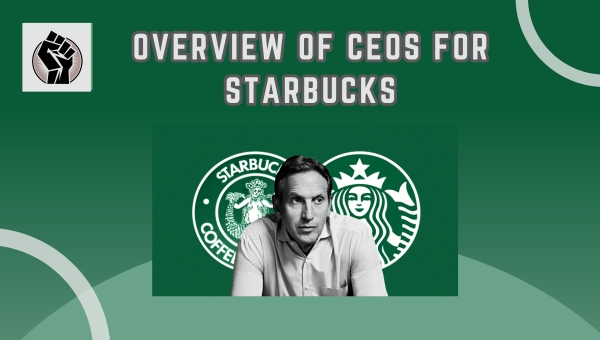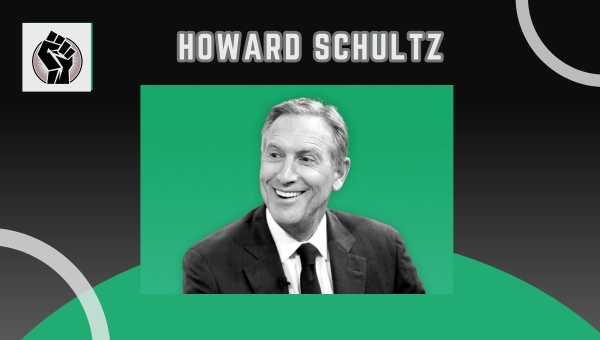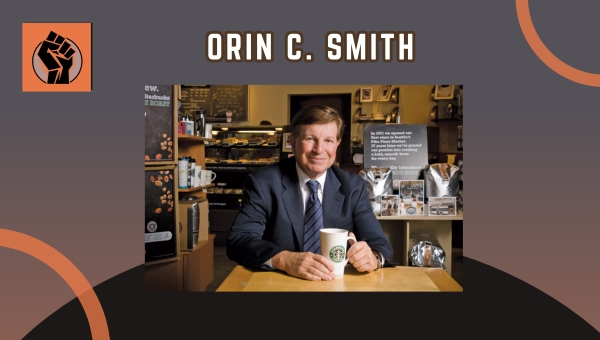Imagine walking into your favorite coffee shop, the aroma of freshly brewed coffee filling the air. Starbucks, a global phenomenon, wasn’t always the juggernaut it is today. Behind its success lies a series of transformative leaders who shaped the company’s journey.
From visionary expansions to digital revolutions, each CEO for Starbucks brought unique strategies to the table, influencing not only coffee culture but also global business practices.
This article dives deep into the achievements and challenges faced by these notable leaders, offering insights into how their leadership transformed Starbucks into a brand recognized worldwide. Prepare to uncover the fascinating stories behind Starbucks’ iconic rise.
Overview of CEOs for Starbucks
Starbucks’ leadership has played a pivotal role in shaping its journey from a small coffee bean retailer to a renowned global brand. Over the years, several CEOs have significantly influenced the company’s trajectory.

Howard Schultz stands out as a transformative leader, expanding Starbucks from a local Seattle store into a global coffeehouse chain. His tenure marked the foundation of the brand’s strong identity and international presence. Orin C. Smith further built on this growth, ensuring profitability during challenging economic periods.
Kevin Johnson’s focus on digital innovation modernized customer engagement, while Jim Donald worked on operational enhancements. Most recently, Laxman Narasimhan took charge in 2023, aiming to address evolving market dynamics. Each CEO has left a distinct imprint, driving Starbucks’ success through different eras.
Notable CEOs for Starbucks
Starbucks has been shaped by several influential leaders who have guided the company through various phases of growth and innovation. Each CEO has left a distinct mark on the brand, contributing to its evolution from a small coffee retailer to a global coffee powerhouse. Here’s a closer look at the notable CEOs who have played pivotal roles in Starbucks’ journey:
Howard Schultz

Tenure: 1987–2000, 2008–2017, Interim 2022–2023
Howard Schultz is arguably the most influential CEO in Starbucks’ history. He initially joined the company in 1982 as the Director of Retail Operations and Marketing. Under his leadership, Starbucks transformed from a small coffee bean retailer into a globally recognized coffeehouse chain.
Schultz played a vital role in expanding Starbucks from a mere 11 stores to over 28,000 locations worldwide by the time he stepped down. His vision brought the concept of café culture to the forefront, emphasizing the importance of customer experience.
Key Achievements:
- Led Starbucks through its Initial Public Offering (IPO) in 1992, securing financial growth and stability.
- Introduced groundbreaking customer-first initiatives, such as creating a welcoming “third place” between work and home.
- Expanded Starbucks into international markets, including Japan and China, positioning it as a global brand.
Orin C. Smith

Tenure: 2000–2005
Orin C. Smith succeeded Schultz and focused on maintaining the company’s growth trajectory while ensuring operational efficiency. He is credited with successfully guiding Starbucks through economic challenges during the early 2000s. Smith’s leadership was instrumental in diversifying Starbucks’ product offerings, which included the introduction of new beverages and food items.
Key Achievements:
- Oversaw a significant increase in store count, furthering Starbucks’ dominance in both domestic and international markets.
- Maintained the company’s profitability during the post-9/11 economic downturn, showcasing his strategic acumen.
- Prioritized sustainability by initiating programs such as ethically sourcing coffee beans, laying the foundation for Starbucks’ later environmental goals.
Jim Donald
Tenure: 2005–2008

Jim Donald’s tenure at Starbucks was marked by a strong focus on operational improvements. His hands-on leadership style aimed to enhance the company’s internal processes. However, Donald faced considerable challenges during the financial crisis, which impacted Starbucks’ performance. This period of turbulence ultimately led to Howard Schultz’s return as CEO.
Key Achievements:
- Emphasized cost-cutting measures and operational efficiency to navigate the company through financial uncertainties.
- Worked to strengthen relationships with employees, fostering a sense of community within the organization.
- Despite the challenges, he laid the groundwork for Schultz’s subsequent efforts to revitalize the brand.
Kevin Johnson

Tenure: 2017–2022
Kevin Johnson brought a technology-driven perspective to Starbucks, leveraging his previous experience in the tech industry. His tenure emphasized digital transformation, making Starbucks more accessible and convenient for customers. Johnson prioritized enhancing the customer experience through mobile ordering and payment systems, which became crucial during the pandemic.
Key Achievements:
- Successfully integrated digital features, such as mobile app payments and loyalty programs, boosting customer engagement.
- Focused on sustainability efforts, including a commitment to reducing the company’s carbon footprint.
- Expanded Starbucks’ presence in emerging markets, particularly in Asia, to tap into growing consumer demand.
Laxman Narasimhan
Tenure: 2023–Present
Laxman Narasimhan, the current CEO of Starbucks, brings a wealth of experience from his previous roles in global companies. His leadership is centered on addressing evolving market challenges and adapting to changing consumer preferences. Narasimhan aims to balance Starbucks’ growth with its commitments to sustainability and innovation.
Key Achievements (in progress):
- Developing strategies to navigate post-pandemic consumer behavior and economic fluctuations.
- Leveraging his expertise to strengthen Starbucks’ presence in both existing and new markets.
- Continuing the focus on digital tools and sustainability initiatives to ensure long-term growth.
Also Read: Filipino Balut – Dive into the Filipino Food Tradition
History of Starbucks Leadership
Starbucks’ leadership history demonstrates its transformation from a small Seattle coffee bean retailer to a globally recognized brand. Each CEO has played a pivotal role in shaping its direction, focusing on areas like expansion, innovation, and operational efficiency. Let’s explore the key milestones and evolving leadership styles that have defined Starbucks over the years.
Key Milestones Under Various CEOs
The growth of Starbucks is marked by significant achievements under the guidance of its leaders.
Below are the highlights of their contributions:
- Howard Schultz (1987–2000, 2008–2017, Interim 2022–2023)
- Spearheaded global expansion, growing the company from 11 stores to over 28,000 worldwide.
- Launched Starbucks’ IPO in 1992, establishing its financial stability and market presence.
- Reinforced the brand’s identity by introducing the unique café culture.
- Orin C. Smith (2000–2005)
- Focused on steady global growth while maintaining profitability during economic downturns.
- Strengthened product diversity to appeal to a broader customer base.
- Jim Donald (2005–2008)
- Enhanced operational efficiency and cost management.
- Faced significant challenges due to the financial crisis, impacting company performance.
- Kevin Johnson (2017–2022)
- Led a major shift toward digital transformation, including mobile ordering and payment systems.
- Enhanced customer engagement through technology-driven innovations.
- Laxman Narasimhan (2023–Present)
- Tackling contemporary market challenges while building on the company’s global reputation.
Evolution of Leadership Style
Starbucks has witnessed varied leadership styles, each tailored to specific challenges and opportunities.
Here’s how their approaches evolved over time:
- Howard Schultz
- Visionary leadership focused on creating a community-centric brand experience.
- Emphasized strong customer relationships and brand loyalty.
- Orin C. Smith
- Pragmatic and operationally focused, ensuring balanced growth during uncertain times.
- Prioritized financial stability alongside expansion efforts.
- Jim Donald
- A hands-on leader who concentrated on internal improvements and streamlining operations.
- Struggled with external economic pressures during his tenure.
- Kevin Johnson
- Tech-oriented approach, emphasizing the integration of digital tools into customer service.
- Pioneered innovative solutions to adapt to changing consumer behaviors.
- Laxman Narasimhan
- Bringing a fresh perspective by leveraging his experience in global markets.
- Aiming to align Starbucks with evolving consumer preferences and industry dynamics.
Impacts of Starbucks CEOs on the Brand
The leaders of Starbucks have played a significant role in shaping the brand’s global identity and operational strategies. From driving international expansion to fostering sustainability initiatives, their influence is evident in the company’s trajectory.
However, their decisions have also faced scrutiny and challenges in various areas, reflecting the complexities of managing a global enterprise.
Defining Starbucks’ Global Growth
The global expansion of Starbucks is a testament to the vision and strategies of its leaders. Each CEO contributed uniquely to the company’s footprint:
- Howard Schultz initiated Starbucks’ international growth, introducing the brand to markets like Japan and Europe.
- Orin C. Smith expanded into emerging markets, notably China, ensuring steady growth.
- Kevin Johnson focused on modernizing operations globally, integrating technology to enhance cross-border efficiency.
This collective effort has been instrumental in bringing Starbucks to over 38,000 locations worldwide, solidifying its position as a global coffeehouse leader.
Emphasis on Sustainability and Ethics
Starbucks has progressively embraced sustainability and ethical practices under its leadership.
Key initiatives include:
- Ethical sourcing of coffee beans through partnerships with farmers to ensure fair practices.
- Reducing environmental impact by promoting reusable cups and reducing waste.
- Commitment to carbon neutrality and sustainable energy use across stores and operations.
These actions reflect the company’s growing focus on aligning its operations with environmental and social responsibility.
Challenges and Controversies
Despite its successes, Starbucks has faced several challenges under different CEOs, highlighting the complexities of leadership in a global brand:
- Labor disputes arose during Howard Schultz’s tenure, reflecting tensions around employee wages and benefits.
- Jim Donald’s administration faced criticism for insufficient responses to operational inefficiencies during financial downturns.
- Kevin Johnson encountered public backlash related to incidents of racial discrimination, prompting corporate policy changes.
These controversies underscore the challenges of maintaining a balance between business objectives and public expectations.
Also Read: Honest Tea: A Journey Through Its Inspiring History
Lessons From Starbucks’ Leadership
Starbucks provides a rich case study in leadership, offering several valuable lessons for aspiring leaders and businesses. Adaptability stands out as a key takeaway, with leaders like Howard Schultz demonstrating how shifting strategies can fuel long-term success. His focus on creating a unique customer experience set the tone for Starbucks’ brand identity.
Another important insight is the emphasis on employee engagement. Starbucks’ leaders have shown that prioritizing the workforce contributes to a positive company culture, which, in turn, drives performance. Digital transformation under Kevin Johnson highlights the need to stay relevant in an ever-evolving market.
Additionally, balancing innovation with maintaining core values emerged as crucial. Starbucks’ leadership consistently worked to align business goals with community impact, ensuring the brand remained trusted globally. These aspects collectively underscore the importance of vision, resilience, and adaptability in leadership.
FAQs
Who started the company Starbucks?
Starbucks was founded by Jerry Baldwin, Zev Siegl, and Gordon Bowker in 1971. The company began as a small coffee bean retailer and roastery in Seattle, Washington.
What year did Starbucks come out?
Starbucks opened its doors in 1971 in Seattle. It initially focused on high-quality coffee beans and equipment before evolving into the global coffeehouse we know today.
What is the cheapest drink at Starbucks?
The cheapest drink at Starbucks is typically a plain brewed coffee. Prices may vary by location, but it remains one of the most affordable options on their menu.
Conclusion
Starbucks’ journey under its various CEOs showcases a compelling narrative of growth, adaptability, and innovation. From Howard Schultz’s visionary expansion to Kevin Johnson’s digital advancements, each leader has left a lasting imprint on the company. The focus on sustainability and ethical practices further highlights the brand’s commitment to responsible business operations.
However, challenges and controversies have also tested the leadership, offering valuable lessons in resilience and strategic decision-making. By understanding the intricate dynamics of Starbucks’ leadership, one can gain insights into effective management and organizational success.
If you found this article insightful, explore more on our site for additional engaging content about leadership and business strategies!





